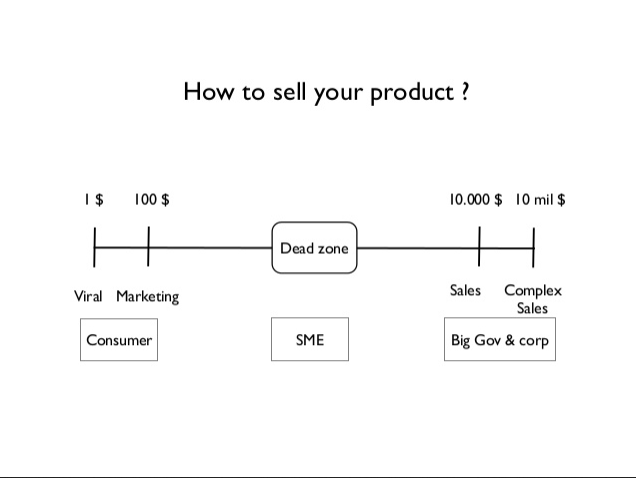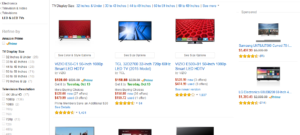 If you read Peter Theil’s Zero to One (which you should, check out my reasons why here), you will come across a short section where he tells budding entrepreneurs how to market, sell, and distribute their new idea. He’s trying to tell them why so many entrepreneurial products/services tend to fail: not because of a bad idea but because of inappropriate sales channels.
If you read Peter Theil’s Zero to One (which you should, check out my reasons why here), you will come across a short section where he tells budding entrepreneurs how to market, sell, and distribute their new idea. He’s trying to tell them why so many entrepreneurial products/services tend to fail: not because of a bad idea but because of inappropriate sales channels.
Are You Selling in the Dead Zone?
The book is focused on entrepreneurs, but there’s one graph that stood out to me because it made all of my sales receptors tingle. While it’s unintentional, it clearly lays out how sales has changed in the world of the internet, and why salespeople must evolve if they want to stay relevant. It looks like this:
Don’t get hung up on the exact dollar amounts that he suggests as the boundaries. I don’t think this was a refined scientific analysis. Rather, it looks at the important trends in how to sell.
By reading between the lines, there’s a lot we can learn about how the sales world is evolving. When we look at the three areas that Peter outlines in the graph, it’s possible to see where sales is dying and where it’s going to take off.
Where the Internet Wins
When people say that sales is dead, they are usually referring to the rise in online buying. This is the left hand side of the spectrum that Peter labels “consumer”, although it isn’t always a B2C sale (Consider the rise of buying office supplies online). If the sales transaction involves:
- A relatively small dollar amount.
- A simple product or service, often a commodity
- Little need for explanation
- Small amounts of risk from a bad purchase (because of trust in the provider or good warranties)
…then people are going to buy online.
C ase in point: the rise of Amazon. As long as I know what I’m getting and the price is below a certain comfort threshold, I’m totally fine with buying online. Even large purchases like a big screen TV or similar appliance, which are well over the $100 limit in the graph, are regularly bought online.
ase in point: the rise of Amazon. As long as I know what I’m getting and the price is below a certain comfort threshold, I’m totally fine with buying online. Even large purchases like a big screen TV or similar appliance, which are well over the $100 limit in the graph, are regularly bought online.
Sales professionals can’t compete with the internet in this space. And they shouldn’t, because quite simply, there’s no money in it. The squeezing of profit margins has been one of the biggest effects of online shopping. This is great for customers who can comparison shop from their computer or phone, but a salesperson will struggle to make money in this environment.
So if you are selling a product or service that fits the four criteria above, start looking for a new gig.
Complexity and Long Sales Cycles
The other end of the spectrum, with its big price tags and long sales cycles, is still a world where salespeople can thrive. This is the world of the B2B salesperson, and this is where the complexity lives that requires a salesperson. There’s also enough margin (i.e. cash) to make it worthwhile. These sales process can’t be left to a marketing website, they need a professional to guide prospective customers through them.
These scenarios have always needed a highly-trained sales force, and that’s not changing. What is changing: the focus of that training. In the past, sales professionals in complex sales processes needed to be information providers. They held the knowledge and there job was to deliver it to the prospects. While they might not admit it, they were often fancy brochure delivery-people or order takers.
That won’t cut it anymore because of, you guessed it, the internet. Easy access to information has changed the role for salespeople in these complex sales. Current research shows that now somewhere between 50-79% of a buyer’s journey is now done before engaging with a sales professional.
Instead of being information providers, sales people have to be guides. Relationship-building and consultative selling, which always held an important place in this sales space, are now even more critical. The sales professionals that can build trust with their prospects, and then walk them through the long sales cycle, are going to be the only ones that survive.
The Balance Point for the Evolved Sales Rep
 That leaves the middle “bracket”, and this is where the sales evolution is most pronounced. It’s still possible to be successful here, but salespeople have to adapt to the new world if they are going to succeed.
That leaves the middle “bracket”, and this is where the sales evolution is most pronounced. It’s still possible to be successful here, but salespeople have to adapt to the new world if they are going to succeed.
Like with large, complex sales, a salesperson has to ask themselves how they can guide their prospects through the sales process in a way that’s more meaningful, easier, or efficient than doing it without help. This is what “adding value” means in the current scenario. The sales person has to be able to ask for the business at the end of the conversation, but they have to also act as a sherpa and lead their prospect through the buying journey.
The skills necessary in this new world aren’t the same as the old-school ones. It’s not just enough to have the resilience to make a lot of sales calls or handle rejection. While those are still useful, the evolved sales person is going to have to understand how to brand and market themselves as a resource to their prospects and customers.
The focus on uncovering prospects’ pain points, and understanding their customers needs, is still relevant. But they need to look at how they can do this in the context of creating a long-term relationship with their customers that creates access, trust, and influence.
The Future of Your Sales Career
Sales isn’t dying. We’re not ready to buy everything and anything online. Until that happens there will be a need for experts to help people find and acquire the products and services they need.
To be successful, though, sales professionals have to be willing to update their skill-sets to mirror what their prospects actually need from them. Their prospects need help navigating the tremendous amount of information that is now available, and they need someone they can trust when they are ready to make a purchase.
The world of the passive order-taker and the aggressive cold-caller has disappeared. Will you evolve or perish?
